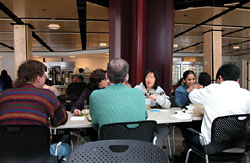
While people aren’t generally considered model organisms, recent advances in robotic sequencing and DNA microarray technology make it easier to carry out genetic studies on individual human beings. For instance, with these tools, we can now compare the genetic differences between healthy and cancerous human cells. And used in combination with the recently completed human genome, these tools allow researchers to study genetic variation in the human population and tease out the factors that contribute to normal variation and disease susceptibility.
On
making meaning of the human genome:
"The genome is a wonderful book of medicine. It gives us insight into how things work. And that will give us the chance to design therapies that have a high efficacy, that really do treat the disease, with a low risk of problems. I can’t wait." — Francis Collins , Director, National Human Genome Research Institute
"We need a total inventory of all the common variations in the human population. There are eight to ten million common sites of variation, and already I reckon we have almost half of them in public databases. Then we have to start correlating them with an individual’s susceptibility to disease, because I think that’s going to turn out to be our best clue as to which genes matter for which diseases. So, if over the next four or five years we were to extract all the functional elements in the genome and be able to capture all the variation in the genome and correlate it with disease, I’d say it’d be a worthwhile half decade or so." — Eric Lander , Director, Whitehead Institute's Center for Genome Research at MIT For more information, visit the Human Genome Project Web site and the Human Genome Resources section of the National Center for Biotechnology Information Web site. |
||||||

 On
comparing human genomes with other model organisms:
On
comparing human genomes with other model organisms:
 On
understanding human genetic variation:
On
understanding human genetic variation: